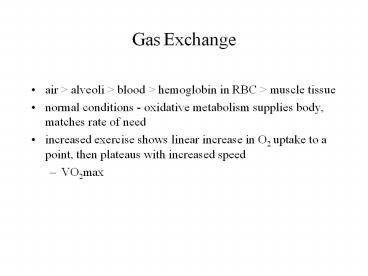Gas Exchange - PowerPoint PPT Presentation
1 / 9
Title:
Gas Exchange
Description:
... by work intensity, fitness and climate. rapid decrease ... re-synthesis of phosphocreatine in exercised muscle. catabolism and anabolism of blood lactate ... – PowerPoint PPT presentation
Number of Views:51
Avg rating:3.0/5.0
Title: Gas Exchange
1
Gas Exchange
- air gt alveoli gt blood gt hemoglobin in RBC gt
muscle tissue - normal conditions - oxidative metabolism supplies
body, matches rate of need - increased exercise shows linear increase in O2
uptake to a point, then plateaus with increased
speed - VO2max
2
VO2max
- maximal amount of oxygen used by the athlete
during maximal exercise to exhaustion - determined by increasing workload or speed of
treadmill in a stepwise manner - Humans 69-85 ml O2/kg/min
- Thoroughbreds 160 ml O2/kg/min
- Greyhounds 100 ml O2/kg/min
- Camel 51 ml O2/kg/min
3
VO2 max
- can be used as an assessment of fitness (ability
for aerobic energy transfer) - VO2 max reached at heart rate of approx. 200 bpm
- horses have higher VO2max per kg BW
- increased heart size
- increased hemoglobin concentration
- increased peripheral capillary bed
- large skeletal muscle mass has higher density of
mitochondria (aerobic metabolism) - spleen gt increased RBC gt increased hemoglobin gt
increased affinity of O2 and enhances O2
diffusion
4
Carbon Dioxide Transport
- dissolved CO2 in plasma
- 5
- carbamino compounds - combined with and amino
group - 15-20
- combined reversibly with H2O
- 60-80
- CO2 H2O ? H2CO3 ? H HCO3-
- with excessive exercise (100 VO2 max), some CO2
not eliminated unique to horse
5
Oxygen Transportation
- small amount dissolved in blood (lt 2)
- combined with hemoglobin (98 )
- 4 O2 molecules per hemoglobin (oxyhemoglobin)
- Hemoglobin
- each gram of oxygen-saturated hemoglobin binds
1.34 ml O2 - 15 g Hg 20.1 ml/100 ml blood
- 20 g Hg 26.8 ml/100 ml blood
- anemia - decreased hemoglobin - O2 content
decreased - oxygen dissociation curve
6
Hemoglobin Dissociation Curve
- Bohr effect (triggered by H in blood)
- right shift of curve due to decreased pH of blood
(acidic) - hemoglobin unloads O2 more readily to muscle
- higher pH in lung, hemoglobin loads up on O2
- muscle pH decreases with exercise
- increases in arterial PCO2 in blood unloads more
O2 - temperature
- right shift with increases blood temperature
- hemoglobin unloads more O2 in heated active
muscle - not much effect at low intensity work level
7
Locomotor-Respiratory Coupling
- effect of natural anatomical driving forces
- walk - no effect
- trot and pace
- ratio 1, 13 or 23
- canter and gallop
- 11
- compression of chest from driving force of weight
on front limbs - pressure of diaphragm
- visceral piston (30 of BW)
- change in axis of body
8
Response to Exercise
- respiration rate and tidal volume increase to
bodies need - regulated by chemoreceptors in response to O2,
CO2 and pH of arteries - locomotion mechanics override chemoreceptors at
canter and gallop
9
Recovery Following Exercise
- affected by work intensity, fitness and climate
- rapid decrease in rate, repay O2 debt
- deep breaths to 60-100 bpm
- re-synthesis of phosphocreatine in exercised
muscle - catabolism and anabolism of blood lactate
- restore hormonal reserves
- lower body temperature
- regulated by airway and skin temperature
- analysis - rate depth, HR, rectal temperature,
and physical state































